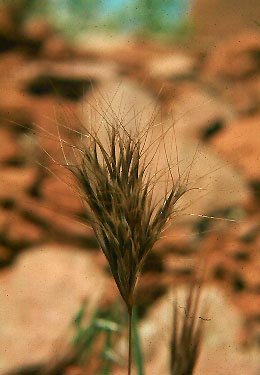Red Brome

Common Name(s):
Red Brome
Foxtail Chess
Scientific Name:
Bromus rubens L.
Scientific Name Synonyms:
None known
Symbol:
BRRU2
Description:
Life Span: Winter annual
Origin: Introduced
Season: Cool
Growth Characteristics: Cool season annual with several to numerous stems from an erect to spreading base, growing 8 to 20 inches tall.
Seedhead: Erect, dense, compact, almost spike-like panicle, 2 to 3 inches long, reddish-purple when mature; lemmas with awns ½ to 1 inch long.
Leaves: Pubescent; blades short, narrow, flat, with veins prominent on both surfaces; sheaths papery; leaves rolled in bud; ligule up to 1/8 inch long.
Ecological Adaptions:
Red brome is an introduced grass adapted to the warmer climates of Utah, found mostly in the semi-desert summer precipitation of southern Utah where the rainfall is 8 to 10 inches annually. It occurs at elevations from 2500 up to 5500 feet.
Soils: It grows in a wide range of soils from shallow to deep and from fine to coarse textures. It does well in limy soils and on hardpan soil.
Associated Species: Associated species include blackbrush, indigobush, sunflower, sand dropseed, and spike dropseed.
Uses and Management:
Red brome is an important forage for cattle and desert tortoise in the early spring. Generally, it is not considered a good forage plant because of the short season of growth. It is a very poor erosion control plant, and provides abundant fuel for wildfire. Red Brome is an indicator of deteriorated range or disturbed sites.
Good management should strive to replace red brome with native range plants high in desirability in terms of volume of production and, more especially, in terms of wind and water erosion control.

